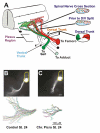Spontaneous rhythmic activity in early chick spinal cord influences distinct motor axon pathfinding decisions
- PMID: 17920131
- PMCID: PMC2233604
- DOI: 10.1016/j.brainresrev.2007.06.021
Spontaneous rhythmic activity in early chick spinal cord influences distinct motor axon pathfinding decisions
Abstract
During embryonic development chick and mouse spinal cords are activated by highly rhythmic episodes of spontaneous bursting activity at very early stages, while motoneurons are still migrating and beginning to extend their axons to the base of the limb. While such spontaneous activity has been shown to be important in refining neural projections once axons have reached their targets, early pathfinding events have been thought to be activity independent. However, in-ovo pharmacological manipulation of the transmitter systems that drive such early activity has shown that early motor axon pathfinding events are highly dependent on the normal pattern of bursting activity. A modest decrease in episode frequency resulted in dorsal-ventral pathfinding errors by lumbar motoneurons, and in the downregulation of several molecules required to successfully execute this guidance decision. In contrast, increasing the episode frequency was without effect on dorsal-ventral pathfinding. However, it prevented the subsequent motoneuron pool specific fasciculation of axons and their targeting to appropriate muscles, resulting in marked segmental pathfinding errors. These observations emphasize the need to better evaluate how such early spontaneous electrical activity may influence the molecular and transcription factor pathways that have been shown to regulate the differentiation of motor and interneuron phenotypes and the formation of spinal cord circuits. The intracellular signaling pathways by which episode frequency affects motor axon pathfinding must now be elucidated and it will be important to more precisely characterize the patterns with which specific subsets of motor and inter-neurons are activated normally and under conditions that alter spinal circuit formation.
Figures



Similar articles
-
Increasing the frequency of spontaneous rhythmic activity disrupts pool-specific axon fasciculation and pathfinding of embryonic spinal motoneurons.J Neurosci. 2006 Dec 6;26(49):12769-80. doi: 10.1523/JNEUROSCI.4170-06.2006. J Neurosci. 2006. PMID: 17151280 Free PMC article.
-
Optogenetic-mediated increases in in vivo spontaneous activity disrupt pool-specific but not dorsal-ventral motoneuron pathfinding.Proc Natl Acad Sci U S A. 2013 Oct 22;110(43):17528-33. doi: 10.1073/pnas.1316457110. Epub 2013 Oct 7. Proc Natl Acad Sci U S A. 2013. PMID: 24101487 Free PMC article.
-
Characterization of rhythmic Ca2+ transients in early embryonic chick motoneurons: Ca2+ sources and effects of altered activation of transmitter receptors.J Neurosci. 2009 Dec 2;29(48):15232-44. doi: 10.1523/JNEUROSCI.3809-09.2009. J Neurosci. 2009. PMID: 19955376 Free PMC article.
-
Motor axon pathfinding.Curr Opin Neurobiol. 1992 Feb;2(1):28-30. doi: 10.1016/0959-4388(92)90157-g. Curr Opin Neurobiol. 1992. PMID: 1638130 Review.
-
Crossing the border: molecular control of motor axon exit.Int J Mol Sci. 2011;12(12):8539-61. doi: 10.3390/ijms12128539. Epub 2011 Nov 29. Int J Mol Sci. 2011. PMID: 22272090 Free PMC article. Review.
Cited by
-
Tonic nicotinic transmission enhances spinal GABAergic presynaptic release and the frequency of spontaneous network activity.Dev Neurobiol. 2016 Mar;76(3):298-312. doi: 10.1002/dneu.22315. Epub 2015 Jun 23. Dev Neurobiol. 2016. PMID: 26061781 Free PMC article.
-
Large-scale synchronized activity in the embryonic brainstem and spinal cord.Front Cell Neurosci. 2013 Apr 5;7:36. doi: 10.3389/fncel.2013.00036. eCollection 2013. Front Cell Neurosci. 2013. PMID: 23596392 Free PMC article.
-
Mechanisms regulating the specificity and strength of muscle afferent inputs in the spinal cord.Ann N Y Acad Sci. 2010 Jun;1198:220-30. doi: 10.1111/j.1749-6632.2010.05538.x. Ann N Y Acad Sci. 2010. PMID: 20536937 Free PMC article.
-
From spontaneous motor activity to coordinated behaviour: a developmental model.PLoS Comput Biol. 2014 Jul 24;10(7):e1003653. doi: 10.1371/journal.pcbi.1003653. eCollection 2014 Jul. PLoS Comput Biol. 2014. PMID: 25057775 Free PMC article.
-
Mechanism for the universal pattern of activity in developing neuronal networks.J Neurophysiol. 2010 Apr;103(4):2208-21. doi: 10.1152/jn.00857.2009. Epub 2010 Feb 17. J Neurophysiol. 2010. PMID: 20164396 Free PMC article.
References
-
- Branchereau P, Morin D, Bonnot A, Ballion B, Chapron J, Viala D. Development of lumbar rhythmic networks: from embryonic to neonate locomotor-like patterns in the mouse. Brain Res. Bull. 2000;53:711–718. - PubMed
-
- Chub N, Mentis GZ, O'Donovan MJ. Chloride-sensitive MEQ fluorescence in chick embryo motoneurons following manipulations of chloride and during spontaneous network activity. J. Neurophysiol. 2006;95:323–330. - PubMed
Publication types
MeSH terms
Grants and funding
LinkOut - more resources
Full Text Sources

